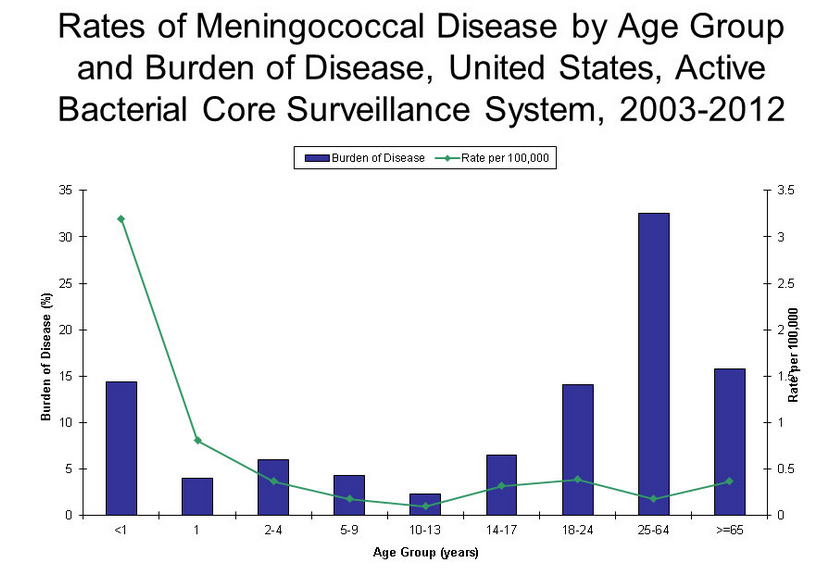Meningococcemia epidemiology and demographics: Difference between revisions
Jump to navigation
Jump to search
No edit summary |
No edit summary |
||
| Line 4: | Line 4: | ||
==Epidemiology and Demographics== | ==Epidemiology and Demographics== | ||
* Case rate is 1-2 per 100,000 in the US in 1980. More recently, there are approximately 2,500 cases of meningococcal infections per year in the United States. | *Case rate is 1-2 per 100,000 in the US in 1980. More recently, there are approximately 2,500 cases of meningococcal infections per year in the United States. | ||
* Since the introduction of ''Haemophilus influenzae'' type b vaccine in 1990 for infants the majority of cases of bacterial meningitis have been in adults; historically 45-87% of cases have been in children. | *Since the introduction of ''Haemophilus influenzae'' type b vaccine in 1990 for infants the majority of cases of bacterial meningitis have been in adults; historically 45-87% of cases have been in children. | ||
* Second most common cause of community-acquired adult bacterial meningitis after pneumococcus. | *It occurs in both endemic and epidemic form | ||
* In West African countries during 1996-1997 there were 213,658 cases and 21,830 deaths due to menigococcal disease. | *Humans are the only natural reservoir of meningococcus. As many as 10% of adolescents and adults are asymptomatic transient carriers of N. meningitidis, most strains of which are not pathogenic (i.e., strains that are not groupable) | ||
*Primary mode is by respiratory droplet spread or by direct contact. | |||
*Meningococcal disease occurs throughout the year, However, the incidence is highest in the late winter and early spring. | |||
*The communicability of ''N. meningitidis'' is generally limited. In studies of households in which a case of meningococcal disease has occurred, only 3%–4% of households had secondary cases. Most households had only one secondary case. Estimates of the risk of secondary transmission are generally 2–4 cases per 1,000 household members at risk. However, this risk is 500–800 times that in the general population. | |||
*Second most common cause of community-acquired adult bacterial meningitis after pneumococcus. | |||
*In West African countries during 1996-1997 there were 213,658 cases and 21,830 deaths due to menigococcal disease. | |||
*Fewer than 1000 cases annually in the United States. Higher rates of disease occur in other countries. The largest burden is in sub-Saharan Africa, where epidemics during the dry season can cause disease in up to 2% of a population, resulting in thousands of cases and deaths during large epidemics. | *Fewer than 1000 cases annually in the United States. Higher rates of disease occur in other countries. The largest burden is in sub-Saharan Africa, where epidemics during the dry season can cause disease in up to 2% of a population, resulting in thousands of cases and deaths during large epidemics. | ||
Revision as of 16:58, 18 November 2014
|
Meningococcemia Microchapters |
|
Diagnosis |
|---|
|
Treatment |
|
Case Studies |
|
Meningococcemia epidemiology and demographics On the Web |
|
American Roentgen Ray Society Images of Meningococcemia epidemiology and demographics |
|
Risk calculators and risk factors for Meningococcemia epidemiology and demographics |
Editor-In-Chief: C. Michael Gibson, M.S., M.D. [1]; Associate Editor(s)-In-Chief: Cafer Zorkun, M.D., Ph.D. [2]
Epidemiology and Demographics
- Case rate is 1-2 per 100,000 in the US in 1980. More recently, there are approximately 2,500 cases of meningococcal infections per year in the United States.
- Since the introduction of Haemophilus influenzae type b vaccine in 1990 for infants the majority of cases of bacterial meningitis have been in adults; historically 45-87% of cases have been in children.
- It occurs in both endemic and epidemic form
- Humans are the only natural reservoir of meningococcus. As many as 10% of adolescents and adults are asymptomatic transient carriers of N. meningitidis, most strains of which are not pathogenic (i.e., strains that are not groupable)
- Primary mode is by respiratory droplet spread or by direct contact.
- Meningococcal disease occurs throughout the year, However, the incidence is highest in the late winter and early spring.
- The communicability of N. meningitidis is generally limited. In studies of households in which a case of meningococcal disease has occurred, only 3%–4% of households had secondary cases. Most households had only one secondary case. Estimates of the risk of secondary transmission are generally 2–4 cases per 1,000 household members at risk. However, this risk is 500–800 times that in the general population.
- Second most common cause of community-acquired adult bacterial meningitis after pneumococcus.
- In West African countries during 1996-1997 there were 213,658 cases and 21,830 deaths due to menigococcal disease.
- Fewer than 1000 cases annually in the United States. Higher rates of disease occur in other countries. The largest burden is in sub-Saharan Africa, where epidemics during the dry season can cause disease in up to 2% of a population, resulting in thousands of cases and deaths during large epidemics.
Age
Most cases of meningococcemia occur in children, but other age groups may be involved as well.

The following are statistics regarding college aged students:
- Rates of meningococcus in US college students as a whole 0.7 per 100,000.
- Rates of meningococcus in US persons aged 18-23 not in college 1.5 per 100,000.
- Rates of freshmen living in dormitories 4.6 per 100,000.
- Rates for college students in UK 13.2 per 100,000 versus those not in college of 5.5 per 100,000.